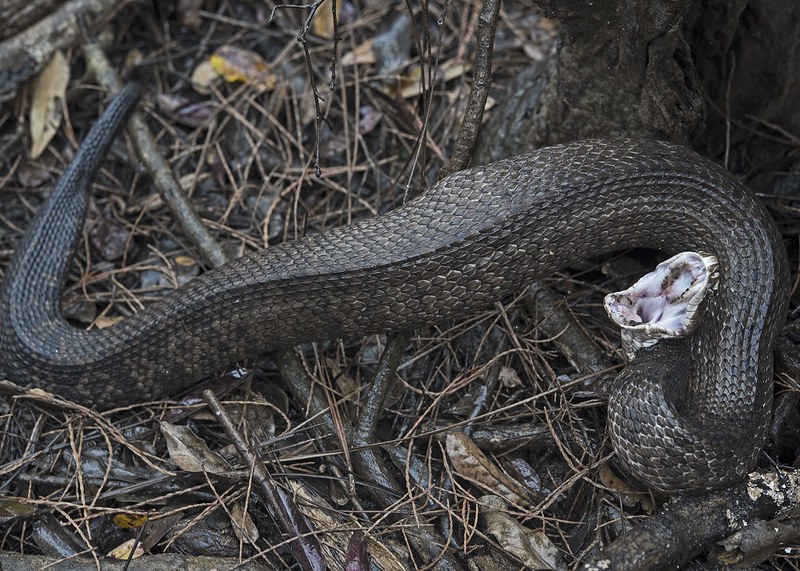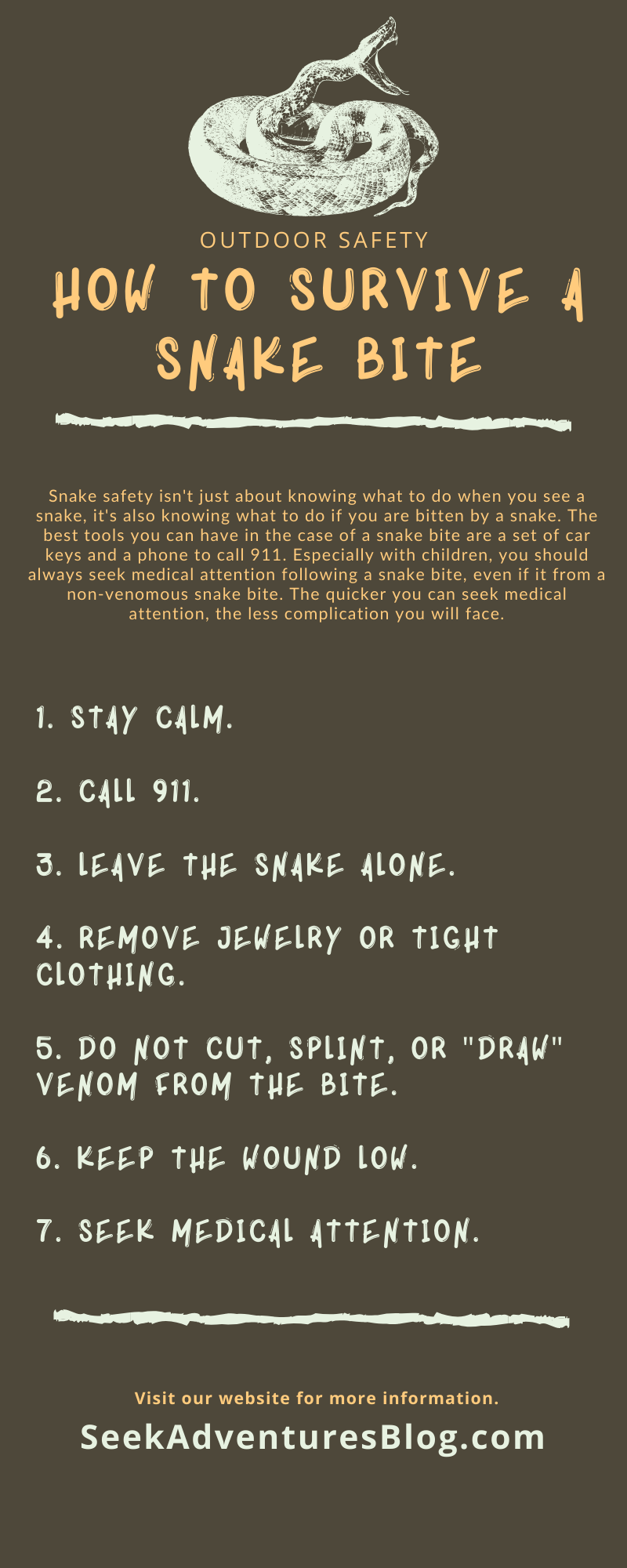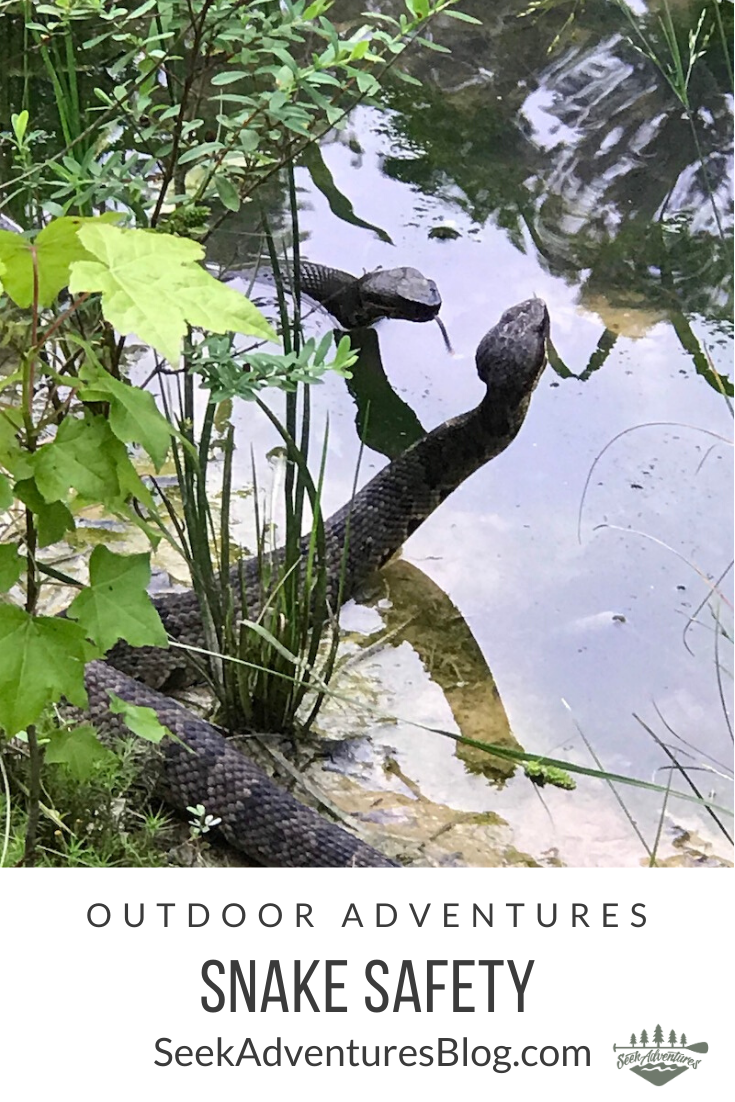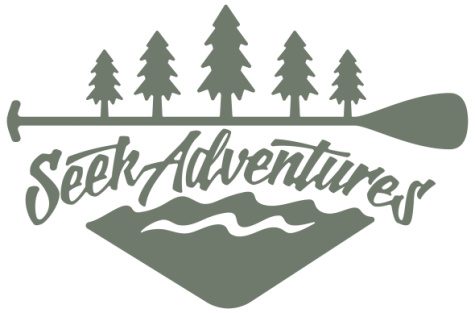Snakes are a part of being outdoors and if you share the world with venomous snakes there are some steps you need to take to keep yourself and your kids safe. Snake safety can keep you from getting injured so you can enjoy your time in the outdoors. When you head outside this season, practice these snake safety tips.
Arkansas is home to six venomous snakes. Around our home, copperheads and water moccasin (cottonmouth) are the most common, although we have spotted a Timber rattler on two occasions.

Snake Safety for Kids and Families
When we walk in the woods, or even in our yard, I am always panning the landscape keeping an eye out for snakes. George, like most kids, is just enjoying life and running and playing, not looking for some snakes. So how do we keep him and ourselves safe?
1. Don’t Freak Out About Snakes
Kids will often mirror your reaction and if you freak out when you see a snake, your child will most likely do the same. It’s often been said that wild animals can sense your fear. While I don’t know how true that is, I do know that fear can lead you to react in an unsafe manner which can in turn cause harm to you or your child.
When you spot a snake it is also watching you or at least aware of your presence. Fast and sudden movement can cause a snake to react defensively which could lead to being bit.
2. Learn to Recognize a Snakes Defensive Reactions
Despite common myths, snakes are not out to get you and will not follow you, chase you, or hunt you down. Snakes WILL protect themselves if they feel threatened. And, just like humans, different snakes feel threatened by different actions.
I have seen copperheads let my dogs walk over them and sniff them and never move. I have seen a copperhead strike my dog just as it was walking by. When you are in an area where snakes may be, be on guard at all times.
Snakes have several ways of letting you know they feel threatened but they can vary between species and individual snakes. The best thing you can do is keep your distance.
Snake Defense Mechanisms
The Coil – A snake getting ready to strike will often coil or compress its body however a snake can strike from any position.
Play Dead – Snakes will sometimes play dead when it feels threatened. It may roll over onto its back or make its body very limp. Eastern Hognose snakes (my favorite snake) are well known for doing this.
Tail Rattle – We all know that rattlesnakes will rattle their tail but so will other species. If there are dry leaves near a snakes tail when it performs this defensive tactic it can even sound just like a rattlesnake!
Camouflage – Many snakes are designed to blend in very well with their natural habitat. Copper heads are very common in Arkansas and their orange/brown bodies blend in perfectly with the needle littered floors of our pine heavy forests. I shudder to think about the number of copperheads I have missed simply due to their camouflage.
Hiss/Puff – If seeing the snake isn’t enough to scare you away they may make hissing or puffing sounds to get you moving along.
Changing Headshape – Spotting a venomous snake by looking for that “diamond” headshape is only partially effective. Many snakes heads will look this way when they flatten their heads – another defense mechanism. Snakes like the eastern hognose can completely flatten its head making many unknowledgeable people believe they have spotted a cobra!
Flight – Snakes will often move away when threatened.
Strike – Hopefully, you have heeded the other warnings quickly enough to avoid a strike but snakes can and will strike when threatened. ALL SNAKES CAN STRIKE. Striking is not a trait limited to venomous snakes and any snake bite can cause complications.

3. Learn About Snakes in Your Area
Snakes terrified me until I started learning about them. When I became a mom, I knew I wanted my son to love and enjoy the outdoors, and snakes are a part of that. I knew it was time to move beyond my own fear and the biggest factor in quelling that fear has been educating myself about snakes, particularly the snakes we have here in Arkansas. Snake knowledge = snake safety!
I have also made it a point to share that information with George and here are a few ways I have done that:
- Visit snake exhibits at local nature centers or a local zoo.
- Check out books about snakes from the library.
- Purchased some local snake ID booklets and look at them regularly.
- Join local snake ID groups on Facebook. Here is our favorite Arkansas Group.
- Look for snakes when you walk or hike and talk about them when you see them.
4. Hike and Play Outdoors Responsibly
Remember that when you are outdoors, you are sharing the space where wildlife live. Being respectful of the fact that you are a guest in their space will help keep you safe.
Always check outdoor play areas for any snakes. Remove piles of sticks, leaves or trash as many snakes like to use these as hiding spots. Keep the grass mowed and weeds down in areas where children will be playing.
When hiking, teach your child the importance of sticking to the trail. Not only does this keep shared natural spaces looking nice, it protects you from animals and snakes that may be off the trails.
5. Teach Your Child What to Do If They See a Snake
As my son gets older he will have more freedom in the outdoors which also means he will need to be responsible for his own safety. Even though he is only three, we make sure to talk about snakes regularly so he knows what to do if (when) he sees one.
I was never so proud as I was last week when we were walking and he stopped, took several steps backward, pointed and said, “Mommy, what’s that?” It turned out to be just an old bicycle tire tube wrapped around a tree, but he did everything right had it truly been a snake.
Here is what you should do when you see a snake:
- Stay Calm. Rember that snakes will react to the situation and if you freak out, they like will too.
- Freeze and Watch. If you are at least three feet from the snake, freezing in place and observe the snakes behaviors. Does it have a way to escape? Is it agitated? Is it preventing you from continuing along your path? This is always a great time to make a quick visual ID of the snake’s species.
- Back Away Slowly. Remember, snakes do not like sudden movements. If the snake is cornered or you wish to retreat, back away slowly. (Just be aware of where you are backing up to!)
- Go Around. If the snake is not bothered and it is safe to go around the snake while maintaining a distance of at least three feet, you may do so. Remember to give a wide berth and move slowly.
- Tell an Adult. In our family, we always announce “snake” when we freeze and point. This alerts everyone else that they should freeze and immediately indicates the area of potential danger. If George were to spot a snake while alone, he also knows to immediately come and tell us where he saw the snake and to give us any identifying factors that he can recall.

What to Do If You Get a Snake Bite
Snake safety isn’t just about knowing what to do when you see a snake, it’s also knowing what to do if you are bitten by a snake. The best tools you can have in the case of a snake bite are a set of car keys and a phone to call 911. Especially with children, you should always seek medical attention following a snake bite, even if it from a non-venomous snake bite. The quicker you can seek medical attention, the less complication you will face.
- Stay Calm. A snake bite is scary but staying calm can help keep the victim’s heart rate down which will slow the spread of any venom.
- Call 911.
- Leave the Snake Alone. Don’t try to kill or capture the snake. The hospital doesn’t need the snake to treat you. If you can identify the species or provide information about its size, color and pattern that can also be helpful to your medical team.
- Remove Jewelry or Tight Clothing. Swelling is very likely in the case of a snake bite so it is important to remove any articles that could further restrict blood flow.
- Do NOT Cut, Splint, or “Draw” Venom From the Bite. Other than a quick wash with soap and water, home treatment of the wound is unnecessary and in many cases may cause more damage.
- Keep the Wound Low. Keep the wound, which will likely be on the hand or ankle, below your heart to slow blood flow.
- Seek Medical Attention. Depending on where you live, it may be faster to drive the victim to the hospital rather than wait on an ambulance. Never drive if you are the victim. If you intend to drive, ask the 911 operator to alert the hospital that you are in route so they are prepared for your arrival.
In the US, venomous snake bites are uncomfortable and can make you very sick but they are rarely fatal. Seeking medical treatment as quickly as possible is your best course of action.
Read Next
- How to Identify Snakes in the Wild | Snake ID Tips
- Hiking With Kids | Which Insect Repellent Do I Need?
- S-S-S-Snakes in Arkansas
- 5 Reasons to Use a Walking Stick
- Water Safety Tips for Toddlers and Children
- How to Identify Poison Ivy
Pin this post about Snake Safety to Pinterest to save it for later.

